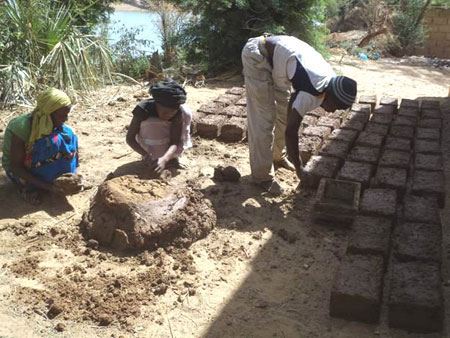|
Community-Led Development Makes A Real Difference In A Senegalese Community

Driving through the countryside in Senegal, it is easy to become dismayed by all of the plastic bags. They are everywhere, becoming more noticeable as one approaches a community. They are mixed in with the earth in the ditches, on the road berm, and in the portions of the countryside nearest the roadway.
Guédé Chantier is no exception. After hearing Guédé Mayor Ousmane Pame talking on the radio about the Eco-Commune movement and Guédé’s participation in it, a group of young adults from Guédé approached him and said they wanted to do something about the plastic litter in town. The result was the formation of the Eco-Sentinelles in early 2013 – they celebrated their first anniversary while Harwood was making his February visit. The Eco-Sentinelles is made up of young adults from their late teens into their forties. The President of the group is Binta Dieng.
In their first year, the Eco-Sentinelles held a large number of work days, open to the participation of the whole community, to begin to clean up the plastic litter. They also presented programs of traditional songs, clothing, and customs to the community, particularly the children. In addition, during big events they invite officials in the region—the Prefect, various NGO managers, and religious leaders like Imam Ly – to attend.
They stage theatre shows to sensitize the local population to the risks posed by agricultural chemicals and the necessity to preserve our natural resources – theatre is a perfect medium as many people can neither read nor write. The result of their action is that it has inspired other young people in the neighborhood in Guédé who now organize cultural events, clean up their districts.
The Eco-Sentinelles put in a significant amount of work clearing a large building of garbage. At one time, the building housed the water pumping station. It also sheltered the first electric generator installed by the Chinese to provide power to the village – Guédé was the first village in the area to have electricity. This was part of the Chinese campaign to try and convince Guédé to embrace communism. After the Chinese left, the “Station de Pompage” was abandoned when the city received electricity from the national grid. With no other use for the building, it filled with garbage, almost to the top.
Under the Eco-Sentinelles, the building has been renamed “Environment House,” a place of focus for the group’s activities and large community meetings. Recently they swept out the building and washed it in preparation for a report by the mayor and municipal council of their actions and expenditures since the last election in 2009. The meeting was attended by an overflow crowd of more than 260 people. Pictures of this meeting can be seen at http://tinyurl.com/p5aqwfb.
During Harwood’s visit, the Eco-Sentinelles met with him nearly each day as they were eager to learn about ways in which they could improve their community. In their first evening meeting with Harwood, they talked about the activities they had undertaken to acquaint the children of the community with their cultural heritage as Haalpulaar.
The next day, during a meeting with Amadou Saïdou Diallo, the District Chief of Fresbe, he showed Harwood a traditional building made of mudbrick. He explained how the building was warmer in the winter and cooler in the summer than a building made of concrete block with a tile or corrugated tin roof. As he talked about the nature of the building, he lamented the fact that the traditional knowledge about mudbrick construction was being lost because young people were not interested.

Members of the Eco-Sentinelles of Guédé Chantier, Senegal form mudbricks that were set out to dry and then used to add a new classroom to one of the community’s elementary schools.
At that evening’s meeting with the Eco-Sentinelles, Harwood was to respond to the information they had shared the evening before. Among other things, Harwood suggested that maybe some of them might want to meet with Chief Diallo and learn how to make mudbricks. During the meeting the next evening Binta announced that she was dividing the group into four committees, culture, social, environment, and economy and assigning the learning about mudbrick construction to the culture committee.
In a recent Skype conversation with Mayor Pame, Harwood was flabbergasted to learn that the Eco-Sentinelles had not only learned about making mudbricks, they had used them to build a new classroom for one of the elementary schools in the community; the number of children who can attend school is in part limited by the number of classrooms, so this activity will have a long-term beneficial impact on the community.
The members of the group have also decided that they need to learn to speak English so they can take part in the ecovillage design courses being offered in various parts in the world, mostly in English speaking countries. In May a young American volunteer will begin conducting English classes.
The Eco-Sentinelles look after the computer room in the community and take time to learn computer skills and the use of basic programs like Word and Excel. During the rainy season they planted trees in the schoolyards and other areas around town. They are also following up on a suggestion by Harwood that they work on reestablishing the Genetic Resource Center in Guédé, an assignment given to the economy committee. It will be interesting to see what exciting, but unanticipated, activities come out of their work on the Genetic Resource Center.∆
DR. DARYLL E. RAY: Blasingame Chair of Excellence in Agricultural Policy, Institute of Agriculture, University of Tennessee
DR. HARWOOD D. SCHAFFER: Research Assistant Professor at APAC, University of Tennessee
|
|